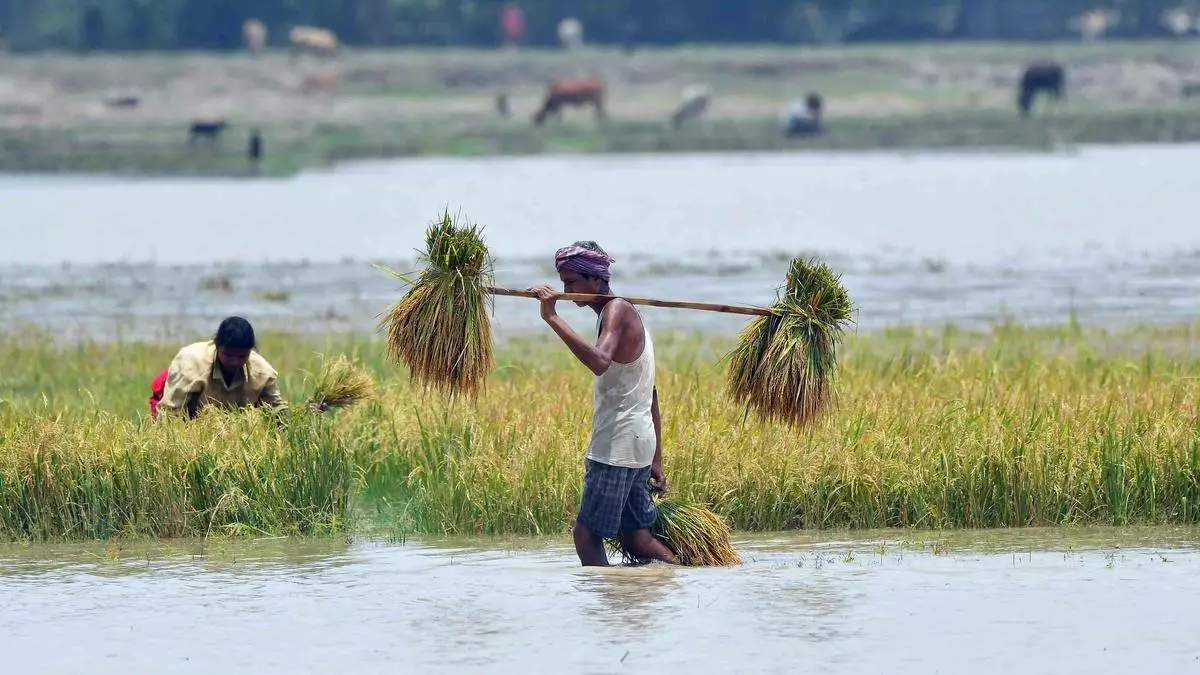Make farming consistent with climatic considerations, says Economic Survey
Amid deficient rainfall in 23 per cent of the geographical areas, covering as many as 280 districts out of a total 729 districts across the country as of Monday, experts are deliberating on the risk it poses to agriculture production. However, it is unlikely to have any major impact this year given the rainfall distribution, so far, and also from the sowing data.
The Chief Economic Advisor V Anantha Nageswaran reflected on the risk factor in agriculture and mentioned that 31 per cent of States including Haryana, Punjab, Himachal Pradesh, Odisha, Bihar and Jharkhand received deficient rainfall between June 1 and July 20.
June deficit
Though Punjab and Haryana have over 40 per cent deficiency, both States are largely irrigated. On the other hand, Himachal Pradesh is not a surplus producer in agriculture. The north-west meteorological subdivision comprising Punjab, Haryana, Rajasthan, Uttar Pradesh, Uttarakhand, Himachal Pradesh and Jammu and Kashmir, has reported 128.6 mm rainfall, which is 4.7 per cent below normal 135 mm during the July 1-21 period.
“The current deficit of 16 per cent (up to July 22) in the north-west was due to a large deficit (33 per cent) witnessed in June, which has been recovered by rainfall received in July,” said agriculture scientist S K Singh.
Odisha is now under “normal” category after rains due to low pressure in the past few days helped it to recover the deficiency.
The only concern will be Jharkhand, though not a large surplus producer, which has been witnessing deficient rainfall (49 per cent until July 22) for the third year in a row. In 2023, the State experienced 43 per cent below normal monsoon rainfall and in 2022 it was 20 per cent lower. Currently, Bihar has 27 per cent deficiency which may be covered in next two months as the India Meteorological Department (IMD) has predicted more rains.
Among all regions, the south peninsula comprising Kerala, Tamil Nadu, Karnataka, Andhra Pradesh and Telangana has reported 193.6 mm rainfall in July 1-21, which is 42.1 per cent above normal of 136.2 mm. The east and north-east meteorological subdivision comprising West Bengal, Bihar, Jharkhand and North-Eastern states has received 353.2 mm rains, which is 19.4 per cent above normal of 295.9 mm.
Central India comprising Gujarat, Maharashtra, Madhya Pradesh, Chhattisgarh, Odisha and Goa has reported 244.5 mm rainfall, which is 16 per cent above its LPA of 210.7 mm for July 1-21 period.
The Survey said erratic weather patterns and an uneven spatial distribution of the monsoon in 2023 led to a marginal decline in total foodgrain output for in 2023-24 by 0.3 per cent.
Stating that in 2022-23, foodgrain production hit an all-time high of 329.7 million tonnes, and oilseeds production reached 41.4 million tonnes, it said in 2023-24, foodgrain production is slightly lower at 328.8 million tonnes, primarily because of poor and delayed monsoons.
The Survey suggested making farming consistent with climate considerations. Grains such as rice and sugarcane are water-guzzling crops and cultivation of paddy gives rise to methane emissions. “The time has come to promote crop-neutral incentive structures,” it said.
Agriculture is at the confluence of three of the greatest challenges of the 21st century — sustaining food and nutrition security, adaptation and mitigation of climate change, and sustainable use of critical resources such as water, energy, and land, said the Survey. Though agriculture and allied sectors hold significant potential for gainful employment, India is yet to fully exploit the potential of agriculture to contribute to economic growth and employment generation, it said.
The agricultural sector requires a serious structural transformation due to challenges posed by water scarcity and climate change. The surge in agricultural employment in Covid years due to reverse migration, the decline in the growth rate of value addition in agriculture in FY24, and an extremely hot summer in the north-western and central regions of the country in the summer of 2024 with rising water stress and energy consumption make a serious and honest stock-taking of India’s farm sector policies imperative, it said.
It said smallholder farmers need to move to high-value agriculture. “Once the incomes of smallholders increases, they will demand manufactured goods, spurring a manufacturing revolution,” the Survey said.
